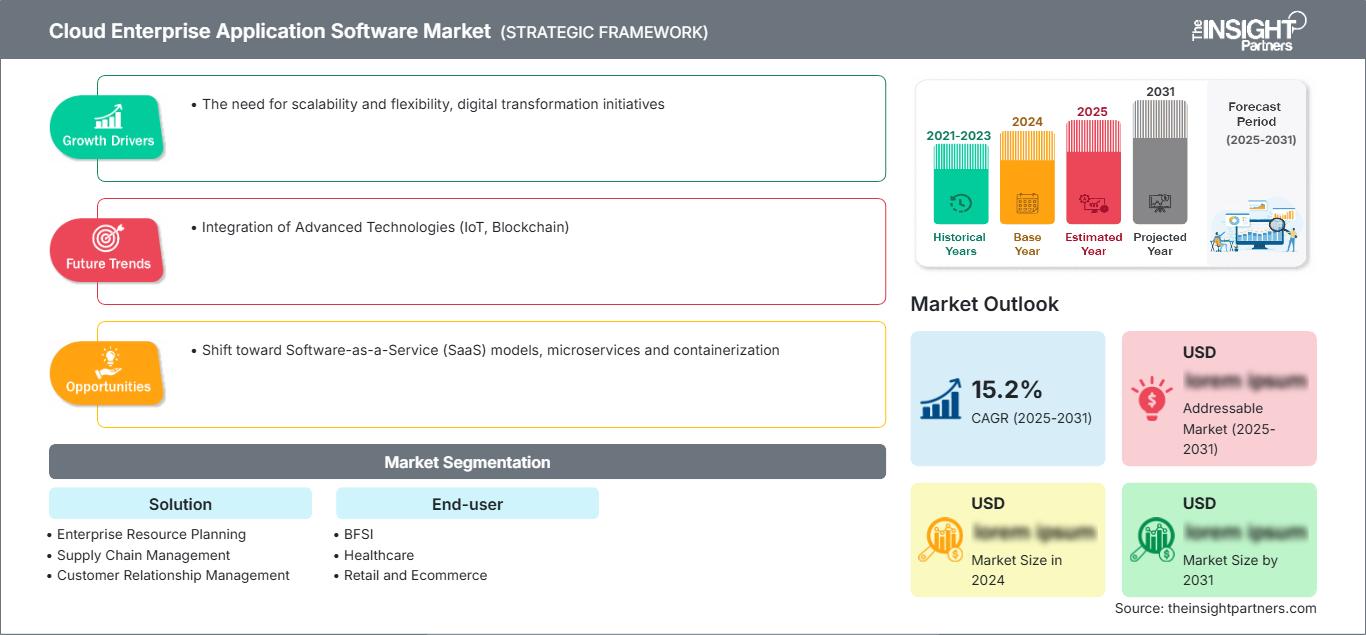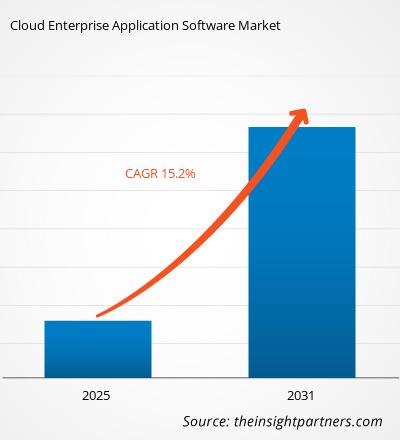Der Markt für Cloud-Unternehmensanwendungssoftware wird zwischen 2023 und 2031 voraussichtlich eine durchschnittliche jährliche Wachstumsrate (CAGR) von 15,2 % verzeichnen. Der Trend zu Software-as-a-Service (SaaS)-Modellen sowie Microservices und Containerisierung dürften weiterhin wichtige Markttrends bleiben.
Marktanalyse für Cloud-Unternehmensanwendungssoftware
- Diese Kategorie umfasst Unternehmensanwendungen, die über das Internet bereitgestellt und von jedem Browser aus zugänglich sind. Es handelt sich dabei um geschäftsorientierte Anwendungen, die von großen Organisationen genutzt werden, um deren Effizienz zu steigern. Sie werden in der Regel von Drittanbietern gehostet und nicht vom Unternehmen selbst gespeichert und verwaltet.
- Cloud-Unternehmensanwendungssoftware wird zunehmend eingesetzt. Einige große Unternehmen ersetzen ihre lokalen Lösungen durch Cloud-basierte Lösungen, da diese flexibler, wirtschaftlicher und leichter erweiterbar sind.
- Cloud-Anwendungen und Shared Computing werden häufig im Finanzwesen, im Gesundheitswesen und in der Fertigungsindustrie eingesetzt. Neben all den Vorteilen gibt es jedoch auch besondere Bedenken hinsichtlich Datensicherheit und Branchenkonformität.
Marktübersicht für Cloud-Unternehmensanwendungssoftware
- Zu den Unternehmen gehören SAP, Oracle, Salesforce, Microsoft und andere. Der Markt ist nach Anwendungstypen (definiert als ERP, CRM, SCM usw.) und Branchen unterteilt.
- KI, IoT und Analytik beeinflussen das Produktangebot. Die Zahl der kleinen und mittleren Unternehmen, die Cloud-Lösungen nutzen, nimmt weiter zu.
- Die COVID-19-Pandemie hat die Nutzung von Cloud Computing verstärkt und die Notwendigkeit der Fernarbeit erhöht, was zu einer steigenden Nachfrage nach cloudbasierter Kollaborations- und Produktivitätssoftware führt.
Passen Sie diesen Bericht Ihren Anforderungen an
Sie erhalten kostenlos Anpassungen an jedem Bericht, einschließlich Teilen dieses Berichts oder einer Analyse auf Länderebene, eines Excel-Datenpakets sowie tolle Angebote und Rabatte für Start-ups und Universitäten.
Markt für Cloud-Unternehmensanwendungssoftware: Strategische Einblicke

- Holen Sie sich die wichtigsten Markttrends aus diesem Bericht.Dieses KOSTENLOSE Beispiel umfasst Datenanalysen, die von Markttrends bis hin zu Schätzungen und Prognosen reichen.
Sie erhalten kostenlos Anpassungen an jedem Bericht, einschließlich Teilen dieses Berichts oder einer Analyse auf Länderebene, eines Excel-Datenpakets sowie tolle Angebote und Rabatte für Start-ups und Universitäten.
Markt für Cloud-Unternehmensanwendungssoftware: Strategische Einblicke

- Holen Sie sich die wichtigsten Markttrends aus diesem Bericht.Dieses KOSTENLOSE Beispiel umfasst Datenanalysen, die von Markttrends bis hin zu Schätzungen und Prognosen reichen.
Markttreiber und -chancen für Cloud-Enterprise-Anwendungssoftware
Bedarf an skalierbaren und flexiblen IT-Lösungen zur Marktförderung
- Skalierbare Cloud-basierte Lösungen machen hohe Investitionen in Hardware und Infrastruktur überflüssig, da nur das in Rechnung gestellt wird, was Sie auch nutzen.
- Unternehmen mit schnell wachsendem IT-Bedarf können schnell skalieren und so die Verzögerungen umgehen, die mit der Reparatur der Infrastruktur auf Eigenleistungsbasis verbunden sind.
- Ein Unternehmen mit saisonaler oder zyklischer Nachfrage (denken Sie an den Einzelhandel) kann seine IT-Ressourcen näher an den Zeitpunkten skalieren, an denen sie wirklich benötigt werden.
- Skalierbare Cloud-Plattformen ermöglichen eine schnellere Bereitstellung neuer Funktionen und Technologien und unterstützen so kontinuierliche Innovationen.
- Flexible Cloud-basierte Lösungen bieten sicheren Zugriff auf Funktionen von überall.
Integration fortschrittlicher Technologien (IoT, Blockchain)
- Dieser Prozess – Die Integration von Kerntechnologien wie IoT und Blockchain in die Cloud-Unternehmensanwendungssoftware bietet beispiellose Wachstumschancen und ermöglicht einen sicheren, reibungslosen Daten- und Aktionsfluss in Echtzeit.
- Eine Vielzahl von IoT-Geräten sammelt kontinuierlich große Datenmengen. Mithilfe der Blockchain-Technologie werden diese Daten sicher erfasst und in der Cloud gespeichert.
- In der Oracle Cloud verarbeiten und analysieren erweiterte Analysen (einschließlich KI und maschinellem Lernen) die Daten, um umsetzbare Erkenntnisse zu gewinnen. Diese Erkenntnisse können automatisch durch Smart Contracts oder Echtzeitaktionen eines IoT-Geräts umgesetzt werden. Schaffung des gewünschten geschlossenen Kreislaufs.
- Dieser integrierte Ansatz ermöglicht die kontinuierliche Erweiterung bestehender Produkte um neue, hochmoderne Funktionen, fördert die Erschließung neuer Marktsegmente, identifiziert und adressiert aufkommende Geschäftsanforderungen an Sicherheit und Transparenz, ermöglicht neue Geschäftsmodelle und zieht eine neue Generation zukunftsorientierter Kunden an.
- Durch die Erweiterung ihrer Cloud-Unternehmensanwendungen mit diesen neuen Technologien können Unternehmen in verschiedenen Branchen von höherer Betriebseffizienz, besser informierten und schnelleren Entscheidungen sowie verbesserten Geschäftsergebnissen profitieren.
Segmentierungsanalyse des Marktberichts für Cloud-Unternehmensanwendungssoftware
Schlüsselsegmente, die zur Ableitung der Marktanalyse für Cloud-Unternehmensanwendungssoftware beigetragen haben, sind Lösung und Endbenutzer.
- Basierend auf der Lösung ist der Markt für Cloud-Unternehmensanwendungssoftware in Enterprise Resource Planning (ERP), Supply Chain Management (SCM), Customer Relationship Management (CRM), Business Intelligence (BI), Webkonferenzen, Geschäftsprozessmanagement (BPM), Content Management System (CMS), Enterprise Asset Management (EAM) und andere unterteilt.
- Basierend auf dem Endbenutzer ist der Cloud-Unternehmensmarkt Der Markt für Anwendungssoftware ist in die Bereiche BFSI, Gesundheitswesen, Einzelhandel und E-Commerce, Behörden, Öl und Gas, Fertigung und andere unterteilt.
Marktanteilsanalyse für Cloud-Enterprise-Anwendungssoftware nach Regionen
- Der Marktbericht für Cloud-Enterprise-Anwendungssoftware umfasst eine detaillierte Analyse von fünf großen geografischen Regionen, einschließlich der aktuellen und historischen Marktgröße sowie Prognosen für 2021 bis 2031 für Nordamerika, Europa, Asien-Pazifik (APAC), Naher Osten und Afrika (MEA) sowie Süd- und Mittelamerika.
- Jede Region ist weiter in entsprechende Länder unterteilt. Dieser Bericht bietet Analysen und Prognosen für mehr als 18 Länder und deckt die Marktdynamik von Cloud-Enterprise-Anwendungssoftware ab, wie z. B. Treiber, Trends und Chancen, die die Märkte auf regionaler Ebene beeinflussen.
- Darüber hinaus umfasst der Bericht eine PEST-Analyse, die die Untersuchung der wichtigsten Faktoren umfasst, die den Markt für Cloud-Enterprise-Anwendungssoftware in diesen Regionen beeinflussen.
Markt für Cloud-Unternehmensanwendungssoftware
Die Analysten von The Insight Partners haben die regionalen Trends und Faktoren, die den Markt für Cloud-Enterprise-Anwendungssoftware im Prognosezeitraum beeinflussen, ausführlich erläutert. In diesem Abschnitt werden auch die Marktsegmente und die geografische Lage von Cloud-Enterprise-Anwendungssoftware in Nordamerika, Europa, im asiatisch-pazifischen Raum, im Nahen Osten und Afrika sowie in Süd- und Mittelamerika erörtert.Umfang des Marktberichts über Cloud-Unternehmensanwendungssoftware
| Berichtsattribut | Einzelheiten |
|---|---|
| Marktgröße in 2024 | US$ XX million |
| Marktgröße nach 2031 | US$ XX Million |
| Globale CAGR (2025 - 2031) | 15.2% |
| Historische Daten | 2021-2023 |
| Prognosezeitraum | 2025-2031 |
| Abgedeckte Segmente |
By Lösung
|
| Abgedeckte Regionen und Länder | Nordamerika
|
| Marktführer und wichtige Unternehmensprofile |
|
Dichte der Marktteilnehmer für Cloud-Enterprise-Anwendungssoftware: Verständnis ihrer Auswirkungen auf die Geschäftsdynamik
Der Markt für Cloud-Enterprise-Anwendungssoftware wächst rasant. Dies wird durch die steigende Endnutzernachfrage aufgrund veränderter Verbraucherpräferenzen, technologischer Fortschritte und eines stärkeren Bewusstseins für die Produktvorteile vorangetrieben. Mit der steigenden Nachfrage erweitern Unternehmen ihr Angebot, entwickeln Innovationen, um den Bedürfnissen der Verbraucher gerecht zu werden, und nutzen neue Trends, was das Marktwachstum weiter ankurbelt.

- Holen Sie sich die Markt für Cloud-Unternehmensanwendungssoftware Übersicht der wichtigsten Akteure
Neuigkeiten und aktuelle Entwicklungen zum Markt für Cloud-Unternehmensanwendungssoftware
Der Markt für Cloud-Unternehmensanwendungssoftware wird durch die Erhebung qualitativer und quantitativer Daten nach Primär- und Sekundärforschung bewertet, die wichtige Unternehmenspublikationen, Verbandsdaten und Datenbanken umfasst. Einige der Entwicklungen auf dem Markt für Cloud-Unternehmensanwendungssoftware sind unten aufgeführt:
- Oracle gab heute bekannt, dass NVIDIA AI Enterprise auf Oracle Cloud Infrastructure Supercluster jetzt in der Oracle US Government Cloud-Region verfügbar ist, um souveräne KI zu unterstützen. Aufbauend auf dem Ausbau ihrer Partnerschaft unterstützen Oracle und NVIDIA Kunden der US-Regierung bei der Schulung und Bereitstellung von KI-Lösungen mit Zugriff auf über 100 Dienste der Oracle Cloud Infrastructure, einschließlich der generativen KI-Dienste, die auf Hochleistungsbeschleunigern wie NVIDIA H100 und NVIDIA A100 Tensor Core GPUs laufen, sowie ultra-latenzarmen Netzwerken und sicherem Speicher. (Quelle: Oracle, Pressemitteilung, April 2024)
Bericht zum Markt für Cloud-Enterprise-Anwendungssoftware – Umfang und Ergebnisse
Der „Markt für Cloud-Enterprise-Anwendungssoftware – Größe und Prognose (2021–2031)“ Der Bericht bietet eine detaillierte Analyse des Marktes und deckt die folgenden Bereiche ab:
- Marktgröße und Prognose für Cloud-Unternehmensanwendungssoftware auf globaler, regionaler und Länderebene für alle abgedeckten wichtigen Marktsegmente
- Markttrends und Marktdynamiken für Cloud-Unternehmensanwendungssoftware wie Treiber, Einschränkungen und wichtige Chancen
- Detaillierte PEST/Porters Five Forces- und SWOT-Analyse
- Marktanalyse für Cloud-Unternehmensanwendungssoftware mit wichtigen Markttrends, globalen und regionalen Rahmenbedingungen, wichtigen Akteuren, Vorschriften und aktuellen Marktentwicklungen
- Branchenlandschafts- und Wettbewerbsanalyse mit Marktkonzentration, Heatmap-Analyse, prominenten Akteuren und aktuellen Entwicklungen für den Markt für Cloud-Unternehmensanwendungssoftware
- Detaillierte Unternehmensprofile
- Historische Analyse (2 Jahre), Basisjahr, Prognose (7 Jahre) mit CAGR
- PEST- und SWOT-Analyse
- Marktgröße Wert/Volumen – Global, Regional, Land
- Branchen- und Wettbewerbslandschaft
- Excel-Datensatz
Aktuelle Berichte
Verwandte Berichte
Erfahrungsberichte
Grund zum Kauf
- Fundierte Entscheidungsfindung
- Marktdynamik verstehen
- Wettbewerbsanalyse
- Kundeneinblicke
- Marktprognosen
- Risikominimierung
- Strategische Planung
- Investitionsbegründung
- Identifizierung neuer Märkte
- Verbesserung von Marketingstrategien
- Steigerung der Betriebseffizienz
- Anpassung an regulatorische Trends




















 Kostenlose Probe anfordern für - Markt für Cloud-Unternehmensanwendungssoftware
Kostenlose Probe anfordern für - Markt für Cloud-Unternehmensanwendungssoftware